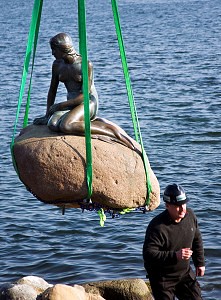
Last night, I attended the last performance of San Francisco Ballet’s “The Little Mermaid” of this season.
The Little Mermaid was choreographed by Hamburg Ballett Director and Chief Choreographer John Neumeier, which was a rethinking of of Hans Christian Andersen’s 1836 tale by the same name. It completely discarded the saccharine cobwebs deposited by Disney machine. Instead, it was a stark and even brutal take of the incomprehension between clueless outsiders and oblivious insiders, and the sorrow of unrequited love.
There was a new character - The Poet, who, like his creation the Little Mermaid, was hopelessly in love with his friend/Prince. The characters of the Prince and the Princes were a little opaque and less sympathetic than one expected, which seemed have robbed the pathos and nobility of Little Mermaid and The Poets's love. Their love for The Prince seemed more foolhardy. Perhaps this was precisely the truth of modern time.
There were fantastic performances from five principal dancers - Yuan Yuan Tan (Mermaid), Tiit Helimets (Prince), Sarah Van Patten (Princess), Damian Smith ( Poet) and Davit Karapetyan (Sea Witch). Tan has always been amazing in modern works and this otherworldly creature showcased her talent like no other roles. The moment she discovered her legs was astoundingly virtuoso and her devastation after the wedding and her failed attempt to kill the Prince rended one's heart. Helimets was every bit of a prince, but I was not sure about the golf club and golf ball he was made attached to. In a vague sense, it reminded me of the bow in Swan Lake. But the bow led to his discovery of the Swan Queen yet here, it served as a comic macho bravado and insensitivity. Another sign of modern time? The Princess was neither good nor bad, simply a pale creature. Despite the limitation of the role, Van Patten lend her grace to the stage. As the lovelorn Poet, Damian Smith created a character full of agony and sense of inferiority yet never lost his dignity. Karapetyan was appropriately monstrous and scary.
In the end, he and his creation (The Little Mermaid) found strength in each other and entered a higher plane of spirituality.
The music by Lera Auerbach was vividly colorful. During the intermission, for a brief moment, I thought the musicians in the pit was practicing for Prokofiev's Romeo and Juliet.
Incidentally, the bronze statue of the little mermaid was removed from the shore in Copenhagen on March 25, 2010 heading to the Shanghai World Expo.
According to the program, this story of Andersen was very autobiographical. Therefore, this universal love of the Little Mermaid is the evidence of power of the transcendent creation.

This ballet was commissioned to commemorate the 200th anniversary of the birth of Andersen. The US premiere of it was highly anticipated and extremely well received. Let's hope that San Francisco Ballet will bring it back in the future seasons.





No comments:
Post a Comment